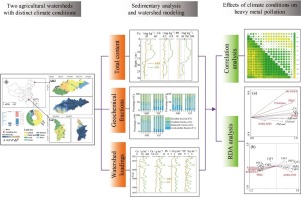当前位置:
X-MOL 学术
›
J. Hazard. Mater.
›
论文详情
Our official English website, www.x-mol.net, welcomes your feedback! (Note: you will need to create a separate account there.)
Heavy metal accumulation, geochemical fractions, and loadings in two agricultural watersheds with distinct climate conditions.
Journal of Hazardous Materials ( IF 13.6 ) Pub Date : 2020-01-17 , DOI: 10.1016/j.jhazmat.2020.122125 Lianhua Liu 1 , Wei Ouyang 1 , Yidi Wang 1 , Mats Tysklind 2 , Fanghua Hao 1 , Hongbin Liu 3 , Xin Hao 1 , Yixue Xu 1 , Chunye Lin 1 , Liya Su 1
Journal of Hazardous Materials ( IF 13.6 ) Pub Date : 2020-01-17 , DOI: 10.1016/j.jhazmat.2020.122125 Lianhua Liu 1 , Wei Ouyang 1 , Yidi Wang 1 , Mats Tysklind 2 , Fanghua Hao 1 , Hongbin Liu 3 , Xin Hao 1 , Yixue Xu 1 , Chunye Lin 1 , Liya Su 1
Affiliation

|
The main aim of this study was to explore the effects of climate conditions on the transport and transformation of heavy metals. Sedimentary geochemical analysis and watershed modeling were used to investigate the distinctions between heavy metal pollution under different climate conditions. The results showed that the average concentrations of Cu, Cd, and Pb in sediments of the subtropical watershed (36.64, 0.60, and 133.69 mg/kg, respectively) were higher than those of the temperate watershed (26.58, 0.19, and 23.17 mg/kg, respectively) because of surface runoff-induced heavy metal loadings under higher precipitation. Also, the labile fractions, which mainly originated from anthropogenic sources, showed higher percentages in the subtropical watershed (67.84-91.33%), thereby indicating that the transport of heavy metals was promoted by surface runoff. Moreover, higher percentages of acid-soluble fractions of Cu and Pb (23.55-33.60%) in the subtropical watershed suggested that higher temperatures accelerated the transformation of heavy metal fractions, thus contributing to the transportation of heavy metals. Overall, climate conditions were the dominant factors for the differences between the subtropical and temperate watersheds. The results of this study suggest that the effects of climate conditions on the transport, enrichment, and bioavailability of heavy metals are of great significance. Such effects should therefore be the focus of future studies.
中文翻译:

在两个气候条件不同的农业流域中,重金属的积累,地球化学成分和负荷。
这项研究的主要目的是探讨气候条件对重金属的运输和转化的影响。利用沉积地球化学分析和分水岭模型研究了不同气候条件下重金属污染之间的区别。结果表明,亚热带流域沉积物中的铜,镉和铅的平均浓度(分别为36.64、0.60和133.69 mg / kg)高于温带流域的沉积物(26.58、0.19和23.17 mg / kg)。千克)分别是因为在更高的降水量下表面径流引起的重金属负载。另外,不稳定组分主要来自人为来源,在亚热带流域中所占百分比更高(67.84-91.33%),因此表明表面径流促进了重金属的运输。此外,亚热带流域中较高比例的铜和铅的酸溶级分(23.55-33.60%)表明较高的温度加速了重金属级分的转化,从而促进了重金属的运输。总体而言,气候条件是造成亚热带和温带流域之间差异的主要因素。这项研究的结果表明,气候条件对重金属的运输,富集和生物利用度的影响具有重要意义。因此,这种影响应成为未来研究的重点。亚热带流域的60%)表明较高的温度加速了重金属组分的转化,从而促进了重金属的运输。总体而言,气候条件是造成亚热带和温带流域之间差异的主要因素。这项研究的结果表明,气候条件对重金属的运输,富集和生物利用度的影响具有重要意义。因此,这种影响应成为未来研究的重点。亚热带流域的60%)表明较高的温度加速了重金属组分的转化,从而促进了重金属的运输。总体而言,气候条件是造成亚热带和温带流域之间差异的主要因素。这项研究的结果表明,气候条件对重金属的运输,富集和生物利用度的影响具有重要意义。因此,这种影响应成为未来研究的重点。重金属的富集和生物利用度具有重要意义。因此,这种影响应成为未来研究的重点。重金属的富集和生物利用度具有重要意义。因此,这种影响应成为未来研究的重点。
更新日期:2020-01-17
中文翻译:

在两个气候条件不同的农业流域中,重金属的积累,地球化学成分和负荷。
这项研究的主要目的是探讨气候条件对重金属的运输和转化的影响。利用沉积地球化学分析和分水岭模型研究了不同气候条件下重金属污染之间的区别。结果表明,亚热带流域沉积物中的铜,镉和铅的平均浓度(分别为36.64、0.60和133.69 mg / kg)高于温带流域的沉积物(26.58、0.19和23.17 mg / kg)。千克)分别是因为在更高的降水量下表面径流引起的重金属负载。另外,不稳定组分主要来自人为来源,在亚热带流域中所占百分比更高(67.84-91.33%),因此表明表面径流促进了重金属的运输。此外,亚热带流域中较高比例的铜和铅的酸溶级分(23.55-33.60%)表明较高的温度加速了重金属级分的转化,从而促进了重金属的运输。总体而言,气候条件是造成亚热带和温带流域之间差异的主要因素。这项研究的结果表明,气候条件对重金属的运输,富集和生物利用度的影响具有重要意义。因此,这种影响应成为未来研究的重点。亚热带流域的60%)表明较高的温度加速了重金属组分的转化,从而促进了重金属的运输。总体而言,气候条件是造成亚热带和温带流域之间差异的主要因素。这项研究的结果表明,气候条件对重金属的运输,富集和生物利用度的影响具有重要意义。因此,这种影响应成为未来研究的重点。亚热带流域的60%)表明较高的温度加速了重金属组分的转化,从而促进了重金属的运输。总体而言,气候条件是造成亚热带和温带流域之间差异的主要因素。这项研究的结果表明,气候条件对重金属的运输,富集和生物利用度的影响具有重要意义。因此,这种影响应成为未来研究的重点。重金属的富集和生物利用度具有重要意义。因此,这种影响应成为未来研究的重点。重金属的富集和生物利用度具有重要意义。因此,这种影响应成为未来研究的重点。

























 京公网安备 11010802027423号
京公网安备 11010802027423号